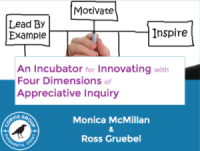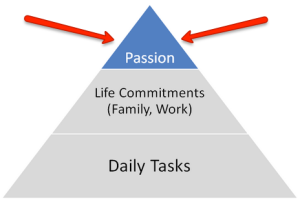I recently led the design and delivery of a one-hour, high-impact training session on how to engineer ideas to a room full of my colleagues: consultants, technical gurus, designers, and senior managers at a global consulting and marketing agency. Prior sessions that my coworkers had designed–each on diverse topics–included 50 minutes of lecture, a few minutes of Q&A with the audience, and then a few minutes of feedback. Thinking to myself, different designs could have more impact, especially for a room full of intelligent adult learners, I wanted to create a session that was more interactive.
A vision began to form in my mind as I designed the course, and it was basically this: provide a lot of research-backed information about how to be a more effective strategy consultant, centered on adult-learning methods, that engages energy, while going deep into the topic. It seemed unrealistic…almost. As I began to recruit a team of fellow organization development peers (a rare breed in the firm!), I realized that our collective minds would be able to bring this vision into reality.
What Is a Vision?
A vision, as Daft (2011) defines it, is “a picture of an ambitious, desirable future for the organization or team.” Let’s break that into manageable chunks: The first part of this definition is to design or paint a picture–perhaps not so literally as creating a piece of art when it comes to organizations and teams, but rather this aspect is more about crafting an image of what the future will look like for the organization. Next, Daft describes visions with the word ambitious. This means that visions require a sort of stretching of the imagination. A new future will take effort to achieve; it will not be simple to accomplish greatness! The term “desirable future” refers to what the organization imagines will serve its stakeholders in a beneficial way. Lastly, Daft’s definition is geared towards organization- and team leaders, who have the responsibility to craft and implement visions. Find out how to develop a vision that fits your organization and how to move towards it.
How to Build a Vision and Deliver It in Four Steps
Based on research from Cooperrider & Whitney (1990), and the subsequent writings by Watkins & Mohr (2001), there are four stages to build a vision and make it happen. These four steps come from the Four-D Model, which has roots in Appreciative Inquiry (AI). Outlined below, anyone can use the Four Ds (discover, dream, design, deliver) for practically any sort of visioning and change work. Whether an individual looking to make a personal life-altering decision; or a team seeking a better way of operating together; or British Airways, a multi-national corporation exploring a new competitive strategy, this model has proved to be impactful (Watkins & Mohr, 2011).
Discover
During this introductory stage, it is important to analyze and explore the organization’s or team’s past successes and accomplishments. The point is to focus creative energy on the positive (Watkins & Mohr, 2011); in this case, what has already worked. At the crux of AI is the attention to possibilities.
Tapping into positive energy from past accomplishments aids the organization or team to catapult itself into a creative mindset. This then transcends into behaviors that enable the organization or team to make strides towards its ambitious vision. When designing the course for my colleagues, I first recognized prior research on AI that I had conducted during graduate school, as well as the previous experiences using an Appreciative Inquiry approach on consulting projects. This, along with the realization that I could build a team to deliver the course, helped me to build confidence that I have knowledge and skills to deliver the ambitious vision.
Dream
In this second phase of the Four-D model, the goal is to tap into the team’s creativity. Brainstorm, ideate, design. Whatever term or concept of dreaming ideas of possible future states (visions!) supports your understanding of this phase will work. No idea is too crazy, stupid, or ridiculous during this step. Encourage teammates with diverse experiences and thinking styles to participate. Research shows that groups with diverse thinking styles come up with better solutions than groups of experts of a singular subject matter (Page, 2007).
Perhaps your mind is getting stuck in negativity: Our budget is too small. We don’t have enough time. Last time we tried this, we failed. Take a deep breath and think about what would be the ideal future state if you had millions of dollars, or 5 more months of time, or if you had succeeded last time. Break free of the negative thinking; be creative. During the course planning, once I had formed a team of co-facilitators, we came up with 4 or 5 designs on how to deliver the course material, not to mention the 20 or 30 iterations of decisions on what that material would be! Every idea was put on the table for consideration, which is part of the next step.
Design
Your creative ideas are beginning to flow by now, and you have at least 5 different ideas, right? Now what? In the Design stage, it is important to begin to make decisions on what your future state should look like. In the Dream phase, you came up with multiple options, ignoring roadblocks, tapping into potential visions of a better future.
Perhaps you have begun to prioritize these ideas into which is most important, or which option best suits the needs of your stakeholders. During the Design phase, you can begin to design an action plan, or map the elements of the decided vision.
Back to the course planning, our committee met one or two times each week to iterate our ideas. We began to capture designs of the slides that would support our lecture points, as well as refine the interactive components. We analyzed each section of the plan, comparing our objectives and desired vision to ensure we kept ourselves on track. By the last planning session, we had created a clear plan for the speaking points, activities, and handouts. We were ready to practice and then deliver.
Each decision you make in this phase to clarify what the organization or team will do to reach its vision will enable successful implementation in the final phase.
This is where the hard work creating a vision pays off. As you begin to roll out the vision and take steps towards reaching it, your team or organization can benefit from a constant reminder of past accomplishments, current skills and abilities, and the desired future state (vision). Perhaps a roadblock pops up during the implementation. Reframing your perspective of “roadblock” to “opportunity to innovate” will allow the organization to maintain a positive outlook and continue to practice using the Four-D model to modify the vision or its delivery.
In the case of the course planning, we delivered the vision on the day of the session. Using the framework of our session plan, our team had confidence that our design would have a positive impact on the participants. At one point, participants were very energetic on a particular part of the session, and so we modified our design live with a mini committee meeting as participants did some small-group work. Our iteration on the design in the moment allowed us to maintain a balanced flow while also covering all the materials. Therefore, it is important to remain flexible as those opportunities for innovation are certain to arise.
Take Action
Now that you have learned the basics of Appreciative Inquiry’s Four-D Model, try it out. This article focused on organization and team, however the model is applicable to individual and community levels as well. Practice the model on your own with a personal vision. Take yourself through some personal discover, dreaming of the future, designing your own action plan, and then making a personal life change. Remember to be ambitions and look for possibilities!
By the way, the course described in this article went well. We met our own objectives and received positive feedback from participants even a week after the session. It was rewarding to try something new, work hard to deliver an ambitious vision, and learn what worked well as well as what we could innovate for the next time.
References
Appreciative Inquiry Commons (n.d.). Cleveland, OH: Case Western Reserve University. Retrieved from: http://appreciativeinquiry.case.edu/default.cfm.
Cooperrider, D.L. & Whitney, D (2001) A positive revolution in change. In Cooperrider, D. L. Sorenson, P., Whitney, D. & Yeager, T. (eds.) Appreciative Inquiry: An Emerging Direction for Organization Development (9-29). Champaign, IL: Stipes.
Daft, R. (2011). The Leadership Experience (5th ed.). Mason, OH: South-Western Cengage Learning.
Page, S. (2007). The Difference: How the Power of Diversity Creates Better Groups, Firms, Schools, and Societies. Princeton, NJ: Princetone University Press.
Watkins, J., & Mohr, B. (2001). Appreciative Inquiry: Change at the Speed of Imagination. San Francisco, CA: Jossey-Bass/Pfeiffer.

